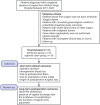Comparative study of laparoscopic peritoneal vaginoplasty versus sigmoid colon vaginoplasty in the treatment of congenital absence of vagina
- PMID: 40764452
- PMCID: PMC12408778
- DOI: 10.1007/s00464-025-11868-1
Comparative study of laparoscopic peritoneal vaginoplasty versus sigmoid colon vaginoplasty in the treatment of congenital absence of vagina
Abstract
Objective: This study aimed to compare laparoscopic peritoneal vaginoplasty and laparoscopic sigmoid colon vaginoplasty in patients with congenital absence of vagina, aiming to provide more robust guidance for clinicians and patients with congenital absence of vagina in choosing the most appropriate surgical approach.
Methods: Patients with congenital absence of vagina who underwent laparoscopic vaginoplasty in our hospital from 2011 to 2023 were included in this study. Participants were divided into two groups: the laparoscopic peritoneal vaginoplasty group (peritoneal group, n = 20) and the laparoscopic sigmoid colon vaginoplasty group (sigmoid colon group, n = 30). Short-term outcomes (operative duration, intraoperative hemorrhage, postoperative ventilation time, time to resume oral intake, length of postoperative hospital stay,) and long-term outcomes (sexual satisfaction, vaginal discharge odor, complications, vaginal mold duration) were evaluated.
Results: Comparative analysis revealed that the peritoneal group demonstrated significantly reduced operative duration (p < 0.01), accelerated postoperative ventilation recovery (p < 0.01), and earlier resumption of oral intake (p < 0.01). No significant intergroup differences were observed in intraoperative blood loss (p = 0.10), length of postoperative hospital stay (p = 0.52), or vaginal discharge odor (p = 1). The peritoneal group had shorter vaginal mold use (p < 0.05) and higher sexual satisfaction (p < 0.01). While the peritoneal group showed a trend toward lower postoperative complication rates (3% vs. 8%), this difference did not reach statistical significance (p = 0.53).
Conclusions: Laparoscopic peritoneal vaginoplasty demonstrates superior perioperative outcomes, optimized intestinal function restoration, reduced requirement for vaginal mold application, and improved sexual satisfaction in patients with congenital absence of vagina. This procedure shows promise as a preferred surgical approach in clinical practice.
Keywords: Congenital absence of vagina; Laparoscopic peritoneal vaginoplasty; Laparoscopic sigmoid colon vaginoplasty.
© 2025. The Author(s).
Conflict of interest statement
Disclosures. Conflicts of interest: Authors Li Yinuo, Li Zihan, Lin Xiaorui, Li Yuting, Huang Yibao, Liu Rong, and Wu Mingfu have no conflicts of interest or financial ties to disclose.
Similar articles
-
Prospective randomized comparison of laparoscopic peritoneal vaginoplasty with laparoscopic sigmoid vaginoplasty for treating congenital vaginal agenesis.Int Urogynecol J. 2013 Jul;24(7):1173-9. doi: 10.1007/s00192-012-1991-9. Epub 2012 Dec 1. Int Urogynecol J. 2013. PMID: 23203401 Clinical Trial.
-
The clinical application of laparoscope-assisted peritoneal vaginoplasty for the treatment of congenital absence of vagina.Int J Gynaecol Obstet. 2016 Jun;133(3):320-4. doi: 10.1016/j.ijgo.2015.11.015. Epub 2016 Mar 2. Int J Gynaecol Obstet. 2016. PMID: 27087418
-
Comparison of laparoscopic peritoneal vaginoplasty and sigmoid colon vaginoplasty performed during radical surgery for primary vaginal carcinoma.World J Surg Oncol. 2014 Sep 30;12:302. doi: 10.1186/1477-7819-12-302. World J Surg Oncol. 2014. PMID: 25266567 Free PMC article.
-
Laparoscopic versus open resection for sigmoid diverticulitis.Cochrane Database Syst Rev. 2017 Nov 25;11(11):CD009277. doi: 10.1002/14651858.CD009277.pub2. Cochrane Database Syst Rev. 2017. PMID: 29178125 Free PMC article.
-
Intestinal vaginoplasty revisited: a review of surgical techniques, complications, and sexual function.J Sex Med. 2014 Jul;11(7):1835-47. doi: 10.1111/jsm.12538. Epub 2014 Apr 4. J Sex Med. 2014. PMID: 24697986
References
-
- Committee on Adolescent Health (2018) ACOG committee opinion No. 728: Mullerian agenesis: diagnosis, management, and treatment. Obstet Gynecol. 10.1097/AOG.0000000000002458 - PubMed
-
- Chen N, Song S, Bao X, Zhu L (2022) Update on Mayer-Rokitansky-Kuster-Hauser syndrome. Front Med. 10.1007/s11684-022-0969-3 - PubMed
-
- Wee A, Bagchi T, Kimble R (2022) Creation and maintenance of neo-vagina with the use of vaginal dilators as first line treatment: results from a quaternary paediatric and adolescent gynaecology service in Australia. Aust N Z J Obstet Gynaecol. 10.1111/ajo.13487 - PubMed
Publication types
MeSH terms
Supplementary concepts
Grants and funding
LinkOut - more resources
Full Text Sources
Medical


